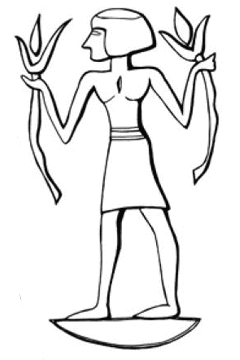The Mistress of the Lionesses
The Tel el-Amarna tablets were found - so far as we know - by an ignorant peasant woman digging for sebakh, the ancient mud brick which, because it has not been farmed for 3,000 years retains much of its original richness and is therefore used by modern Egyptian farmers as fertiliser. She saw in them nothing more than objects that the mad western tourists might pay good money for, so loaded them into a pannier on her donkey, then sat on top of the pannier as the donkey jogged homewards, caring not at all that the contents of the pannier were crumbling under her weight.
The result is that most of the tablets are broken or have letters or lines abraded away around the edges. Unfortunately, it is at the edges that lines or even messages begin, with the result that many of the tablets have lost their addresses and signatures, so that we can only guess at who wrote them.
Among these damaged tablets is one, numbered P#3210 in the standard lists, which comes from "the Lion woman" (or, as others have translated it, "the Mistress of Lionesses"). We don't know her name, we don't even know the name of the city from which she came and apart from being fairly sure that it was in Canaan, that is about all we know about her.
Like most of the tablets, her message to Akhenaton was a plea for help against the robbers and rebels who were pressing in on her city - and like all the other pleas, we can be certain that it went unanswered. Akhenaton was too busy composing another poem in honour of the Aten to concern himself with such minor matters as the loss of empire. While the Heretic Pharaoh may not have been curious as to the identity of this "Lion Woman", the same cannot be said of modern researchers, and two archaeologists in Israel have come up with a novel theory.
Dr Lederman and Professor Bunimovitz have been working at Beth Shemesh, a small tel south-west of Jerusalem which we pass on our way to our site at Mareshah. They have discovered a significant city with rich buildings and extensive storage facilities. They have also found evidence pointing to a violent destruction of the city around 1350 BC - something which pleases them no end, as a good destruction layer is every archaeologist's dream. People didn't have time to remove their belongings and because the city burned so fiercely, the enemy responsible didn't have a chance to loot it - which means that there is all the more left for the archaeologist to find.
Among those findings were an Egyptian scarab seal, bronze arrow heads and many large storage jars. They also found a small plaster plaque that is causing a certain amount of interest.
|
| The Mistress of the Lionesses? |
According to the sketch they have released - no photographs are available as yet, which makes me a trifle suspicous - the plaque shows a vaguely Egyptian figure in a proper Egyptian pose, face and feet pointing left, torso facing forward towards the viewer. The figure is bare-chested and wears a short kilt and in its hands it is clutching two lotuses. "We took this finding to an art historian who confirmed our hypothesis that the figure was a female," says Dr. Lederman.
I suggest that the art expert needs to see a good optician, because neither dress, hair-do nor chest indicate anything other than a perfectly normal male to me. Perhaps the actual object is more female, but my suspicion is that it is even less so, which is why Lederman and Co. are relying on the sketch.
The trouble is that, like all archaeological digs, the Beth Shemesh excavations are in constant need of money, and merely finding a scarab and a few broken pots is hardly likely to have the funding bodies slavering after you with chequebooks at the ready. On the other hand, if you can claim that you have found something unique, something which may - as their press release claims - force upon us a new interpretation of Biblical history, then you are in a much stronger position when it comes to submitting your application for new funding.
My guess is that once this year's funding round is over, we won't hear any more of this "Mistress of the Lionesses". I could be wrong, of course, but let's wait and see.
© Kendall K. Down 2009






